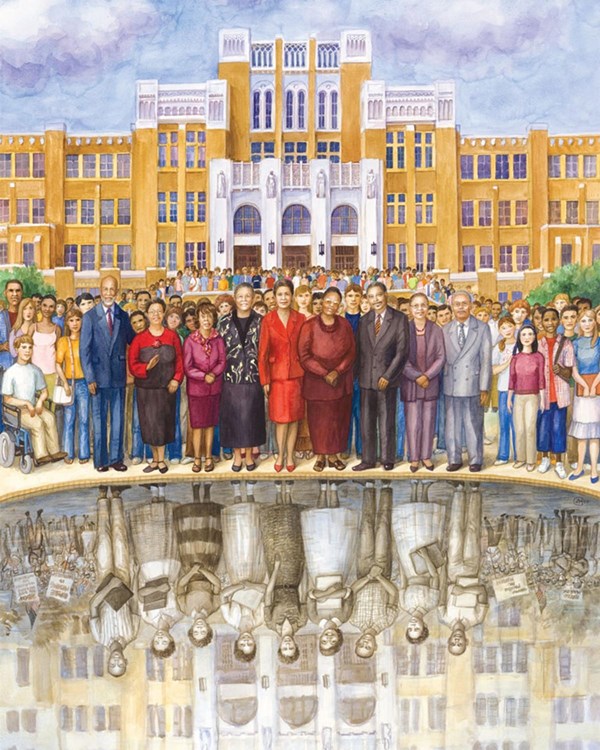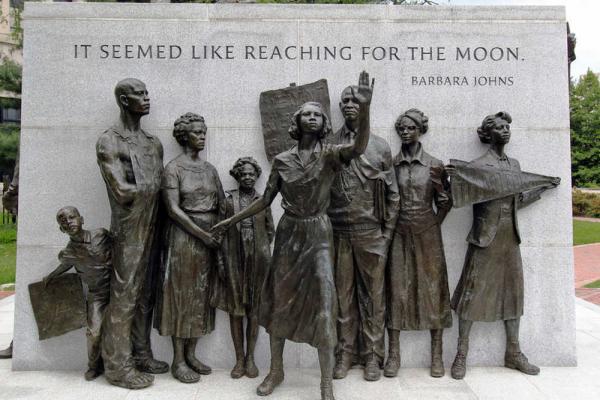ROCK ART

CHARLY PALMER
Little Rock Nine
Little Rock Nine
CHARLY PALMER (Artist)
~

“Reflections” captures the spirit of the Little Rock Nine in 1957& 2007, 50 years post-integration.
Lyuba Bogan
“Reflections”
Luba Bogan (Artist)
~

Elizabeth Eckford Art Print by Matthew Sanderson
“Elizabeth Eckford (Print)”
Matthew Sanderson (Artist)
~

In 1997 artist George Hunt was commissioned to create an image to pay tribute to the event and the nine children who would be the first black students to integrate a white school. This historic Civil Rights event took place in Little Rock, Arkansas at Central High School in 1957. The group would go down in history known as “The Little Rock Nine.”
President Clinton and the First Lady were on hand for the unveiling of the paining and ground breaking for the Central High School Interpretive Center in Little Rock. Mrs. Clinton was so moved by the painting and its message that she requested the opportunity to keep the painting in the White House in Washington while the Center was being funded and build. George Hunt’s painting stayed there for five years before being returned to its permanent home in Little Rock.
In 2005 the United State Post Office issued a series of stamps under the banner, “To Form A More Perfect Union,” celebrating milestones in Civil Rights. The works of 10 artists were selected for the series. George Hunt’s “America Cares/Little Rock Nine” was one of them. George Hunt was honored both in Little Rock and Memphis with receptions celebrating the achievement.
George Hunt has long been recognized as one of the top artists in the South and has also gained a national reputation through touring exhibits and shows from Seattle to New York…and Chicago to New Orleans. His first love is Blues Music which finds its way in to most of his painting. But George Hunt also creates incredible images about Civil Rights, African beauty and the rich history of African-Americans in the South. George Hunt paints with color and feeling.
“Little Rock Nine (Postage Stamp)”
George Hunt (Artist)
~

Ulloa, Domingo. Racism/Incident at Little rock. 1957. Painting. Los Angeles
“Racism/Incident at Little rock”
Domingo Ulloa
~

The Knotted Line by Evan Bissell.
“The Knotted Line “
Evan Bissell (Artist)
~

Virginia Civil Rights Memorial – Bleifeld, Stanely. Barbara Johns. 2008. Civil Rights Memorial, Richmond, Virginia. The efforts of the NAACP and Barbara Johns are portrayed in the Virginia Civil Rights Memorial in Richmond, Virginia. The memorial was revealed in 2008 and was designed by Stanley Bleifeld. Barbara Johns is depicted as leading a group of students and parents in the protest. Her posture and hand placement is a symbol for hope and pride. It reflects that if a young high school student was able to protest and make huge advancements in school desegregation, then many other individuals could have positive impacts on the Civil Rights Movement. Barbara Johns, a sixteen-year-old student at Moton High School, was one of the leading figures for the push for school desegregation. Based on inferior school supplies and conditions, she led a protest that would open the eyes of NAACP lawyers and help start the court case battle of Brown vs. Board of Education. The high school was built to accommodate one hundred and eighty Black students, but lacked many necessary resources. Barbara Johns states that, “I was unhappy with the school facility and its inadequacies … it wasn’t fair that we had such a poor facility, equipment, etc., when our white counterparts enjoyed science laboratories, a huge facility, separate gym dept. etc.” (Heinemann). After walking into the courthouse of Farmville and being denied help, the NAACP intervened. With the aid of Oliver Hill and Spottswood Robinson III, the NAACP attacked the clause “separate but equal.” After Brown vs. Board of Education reached a verdict, Prince Edward County chose to close public schools rather than to integrate them. With the schools closed for five years, white students were able to attend Prince Edward Academy, a private school funded by donations and state grants. It was not until the case of Griffin vs. County School Board of Prince Edward that schools were desegregated in Farmville.
